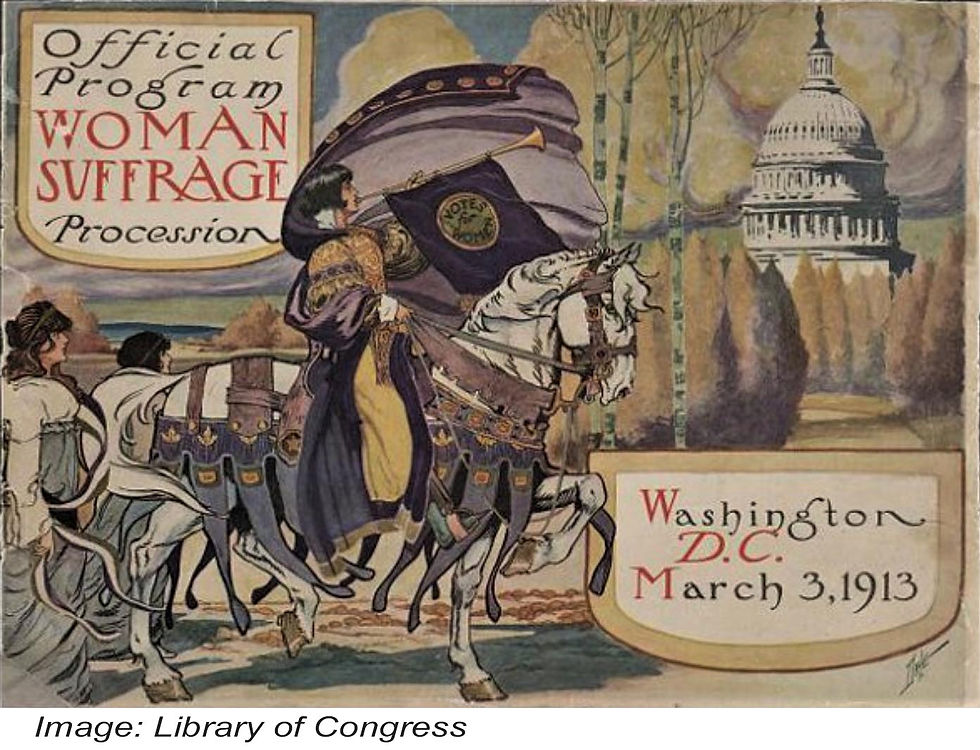Suffrage Must Be “Guaranteed”
- MH Historical Society
- Aug 13, 2020
- 3 min read
100 years ago this month, the 19th Amendment to the U.S. Constitution was ratified and became the law of the land: “The right of citizens of the United States to vote shall not be denied or abridged by the United States or by any State on account of sex.” But in truth, the fight to fully achieve women’s suffrage began nearly a century earlier, and continued long after the 19th amendment was enacted.

Between 1777 and 1807, American women actually LOST the right to vote.
By the mid-1800s, women in various countries around the world had begun forming organizations to fight for women’s rights. Much of the inspiration for U.S. women came from the abolition and temperance movements.
The Seneca Falls Convention was held in New York state in the 1840s, organized by Elizabeth Cady Stanton, Lucretia Mott, Frederick Douglass and others. They drafted the Declaration of Sentiments—modeled after the Declaration of Independence—which demanded equal recognition of women as members of society. One hundred signatures were gathered at the conference. The Declaration of Sentiments became the blueprint for women’s rights and suffrage movements. Its radical demands attracted ridicule by some, but even so, it ignited the spark of progress. It was a victory, but primarily for white women (see reference to 15th Amendment).
In those days, all women were barred from colleges and many professions as well as government and church leadership positions. They had no property ownership rights, no rights to their wages, no child custody rights in a divorce, and no right to vote. They were powerless to influence the very laws that denied them so many fundamental rights guaranteed to men.

At the same time, interracial Female Anti-Slavery Societies (1833-70) had formed in New York and Philadelphia led by women including Charlotte Forten and her daughters Harriet, Margaretta and Sarah; and Mary M’Clintock, among others. Their efforts led to voting rights activism.
In 1866, suffrage leaders including Elizabeth Cady Stanton and Susan B. Anthony, formed the American Equal Rights Association to work for equal rights, including suffrage, regardless of race, color or sex. The American Woman Suffrage Association (AWSA) was formed in 1869.
In 1870, the 15th Amendment guaranteed rights for all “regardless of race, color or previous condition of servitude,” but didn’t explicitly enfranchise women, and racial prejudice persisted, particularly in the South. Sadly, racial tensions caused a split between many white and African-American women suffragists.
The National American Woman Suffrage Association (NAWSA) was formed in 1890. Over the years, some women sought more radical change than others. African-American women leaders including Mary Church Terrell, Josephine Ruffin, Harriet Tubman and Helen Appo Cook went on to found the National Association of Colored Women’s Clubs in 1896.

When World War I began in 1914, many suffrage organizations shifted their focus to supporting the war effort, although some activists continued to focus on suffrage. The tremendous contributions of women during WWI helped shift public opinion to be more favorable to women’s rights in general.
Between 1914 and 1920, another women’s group known first as the Congressional Union and later as the National Woman’s Party (NWP), pressured Congress to enact the 19th Amendment. They had to overcome organized opposition by powerful lobbyists from the railroad, textile and liquor-producing industries. During a 1917 protest, women were demeaned and attacked by bystanders, and thrown in jail for blocking traffic.
Following several more years of concerted effort, American women celebrated the ratification of the 19th Amendment. Cary Chapman Catt formed the League of Women Voters during NAWSA’s last meeting on February 14, 1920, to help newly enfranchised women exercise their right to vote.

But the right to vote was not “guaranteed” to all women, or all people, for some years after the 19th Amendment’s passage. Inspired by pioneers like Harriet Tubman and Sojourner Truth, women suffragists of color continued the fight for equal rights. Along with Mary Church Terrell, women like Ida B. Wells, Frances E. W. Harper, Sarah Parker Remond, Fannie Barrier Williams, Mary Ann Shadd Cary, Ella Baker, Rosa Parks, Amelia Boynton Robinson and Angela Davis, to name a few.
Shortly after the historic civil rights march to Selma, the landmark Voting Rights Act of 1965 sought to overcome legal barriers at the state and local levels that prevented African-American women and men from exercising their right to vote as guaranteed
under the 15th Amendment.
The need to protect suffrage continues.

Don’t miss the Morgan Hill “Women’s Week”
Celebration of Women’s Suffrage
Aug 24-27
Read a book:
Take an online course at Stanford:
HIS 202 – Centennial of Women’s Suffrage, https://stanford.io/30NBUPO
Browse online resources:
Declaration of the Sentiments (NPS): https://bit.ly/31DHa7H
Women’s Suffrage (Women’s History): https://bit.ly/2CkkaSG
Untold Story of Women’s Suffrage (SPLC): https://bit.ly/2PHYovi
Women’s Suffrage (HistoryNet): https://bit.ly/2PHI2Tb







Comments